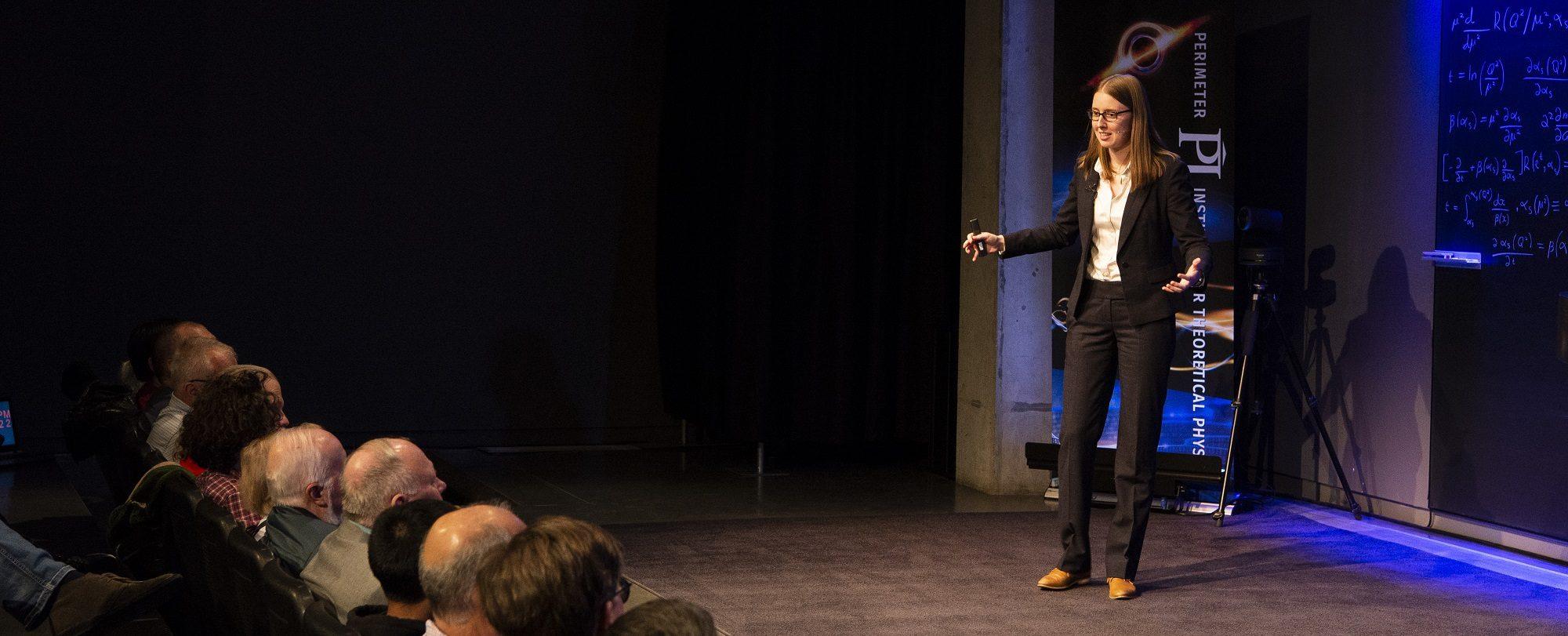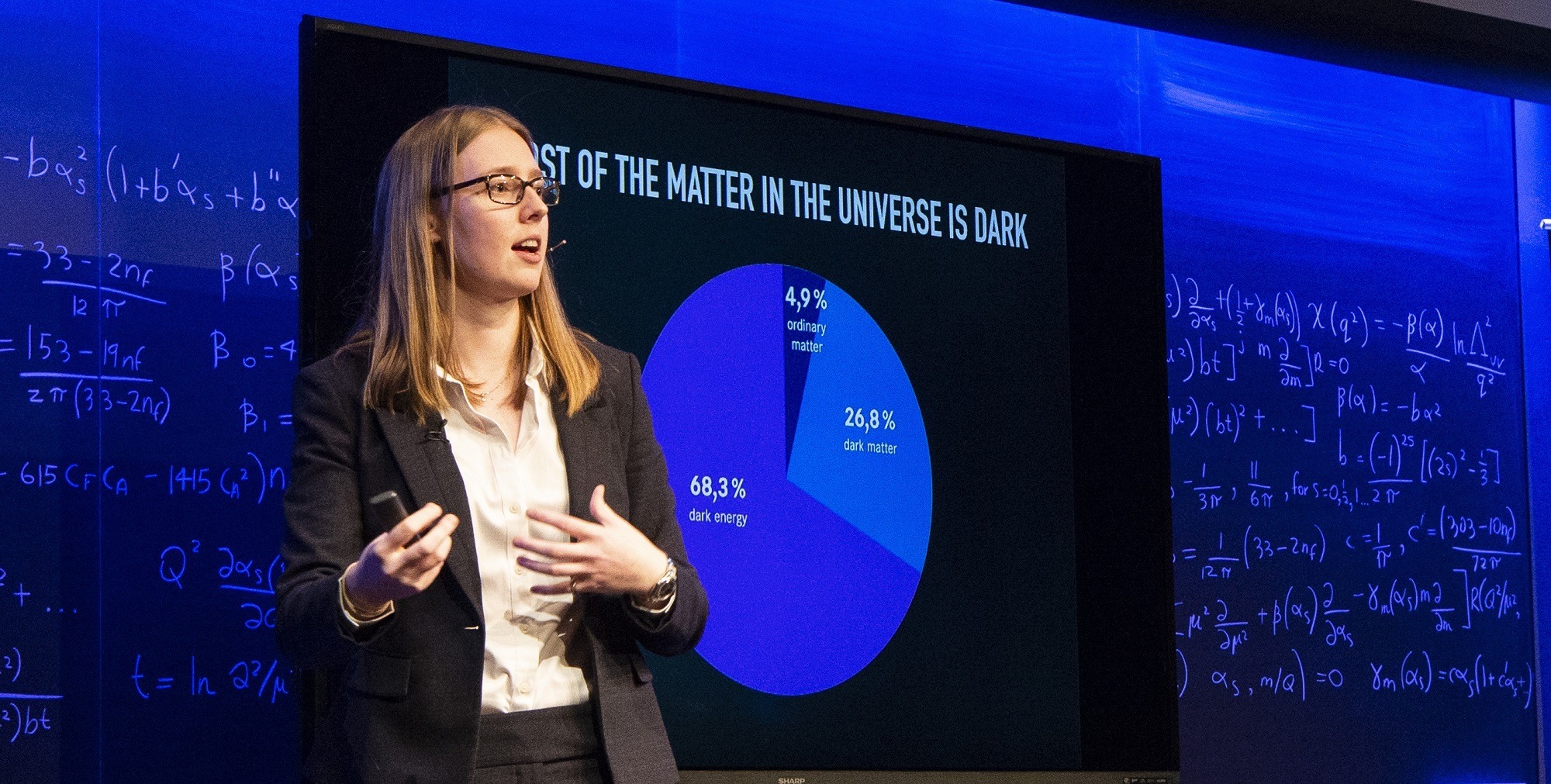Phiala Shanahan builds the universe
With a new approach to calculations and the aid of supercomputers, Emmy Noether Visiting Fellow Phiala Shanahan is rebuilding nuclear physics from the bottom up.
Take a self-guided tour from quantum to cosmos!
With a new approach to calculations and the aid of supercomputers, Emmy Noether Visiting Fellow Phiala Shanahan is rebuilding nuclear physics from the bottom up.

Consider the proton. It is both old and basic, one of the first stable particles created after the big bang. It is also extremely common, as one of three particles that make up the atoms that are all around us. (The other two are the neutron and the electron).
We’ve known about it for a bit more than a century, so at this point, you’d think we’d understand it perfectly, right? Wrong.
We do know that the proton has an internal structure. It is made up matter-carrying particles called quarks, glued tightly together by force-carrying particles called gluons. We know the rules of how quarks and gluons interact. (The theory spelling that out is called quantum chromodynamics, or QCD.)
But here our understanding of the humble proton quickly hits a limit. The problem is that while QCD works brilliantly at high energy – in collider physics, and the like – at the low-energy levels of our everyday world and the protons all around us, the theory is nearly impossible to use.
Even something as basic as the mass of the proton can’t be calculated analytically from first principles. Or, it couldn’t – until now.
Phiala Shananan has changed that. She’s working to crack open low-energy QCD, unravel its dynamics, and use it to calculate the mass of the proton. Not to mention ushering in a new era of nuclear physics. Her work to understand QCD could have implications not just for particle physics, but for the searches for dark matter and other physics beyond the Standard Model.
Shanahan, the youngest Assistant Professor of Physics at MIT, is one of Perimeter Institute’s Simons Emmy Noether Fellows. These visiting fellowships bring exceptional women scientists to Perimeter for periods between a few months and a year, with the aim of giving them a boost at a critical time in their careers. Shanahan was at Perimeter for the fall 2018 semester.
The prominent young Australian scientist – she was on the 2017 Forbes 30 Under 30 list in the science category – was drawn to Perimeter by the chance to concentrate on her research and establish some new collaborations. “There’s no one here who does exactly what I do, and that’s perfect,” she says. “The best way to expand your ideas is to reach across the edges of them.”
Shanahan has been working with Perimeter Associate Faculty member Roger Melko, and, separately, with another Emmy Noether Fellow, Christine Muschik, a faculty member at the Institute for Quantum Computing. Melko leads Perimeter’s collaboration bringing machine intelligence to bear on the complex problems of condensed matter physics. Muschik is an expert in quantum computing. For Shanahan, both avenues offer possible ways of lining up more computational oomph to use in her work unsnarling low-energy QCD.
Low-energy QCD is in such a snarl because, in the parlance of the field, its non-perturbative. Most everyday physics is perturbative. Practically speaking, that means we can make rough calculations based on approximations, and then dial in on more correct answers through a series of small corrections.

If you bumped, or “perturbed,” a swinging pendulum, the resulting motion would probably be a swing with a wobble in it. If you wanted to describe the motion mathematically, you could get close by writing down the well-known equations for the basic swing and then adding a bit of math to represent the wobble. The pendulum has been perturbed, and perturbative methods can be applied.
A non-perturbative pendulum would be a different story. The wobble would likely be bigger than the swing, and the resulting motion would be a complex mixture of both. You could only describe it by including both wobble and swing in the calculations from the beginning, which is much more difficult. Many non-perturbative physics problems, in fact, have not been solved analytically at all.
That is the case with low-energy QCD, says Shanahan. “The theory is elegant, but we can’t sit down and calculate the thing we’d like to know from the Standard Model – like the mass of the proton. We don’t know how to do the maths, how to solve the equations. So what we do instead is put theory onto a computer.”
The proton, which in its simplest description is three quarks and some gluons, gets non-perturbative when you look a little closer. Quark and antiquark pairs appear from the vacuum, gluons are emitted and absorbed, and the result, says Shanahan, is a “bubbling, boiling, dynamically complicated structure.”
Since the theory here is non-perturbative, not one of these bubbles, boils, or wobbles can be ignored. But a computer needs a place to start, a way to order the calculation, so Shanahan takes the theory and cuts it into pieces, or, as she puts it, “discretizes the theory and puts it on a four-dimensional space-time grid.”
This is analogous to increasing the pixel density of a complicated image. With a nine pixel square, you would gain a rough sense of the image’s shape. But if you divide each of those pixels into its own grid of pixels, and then again, and again, a clearer picture emerges. By making the grid on which she puts the computation smaller and smaller, Shanahan can get closer and closer to the true answer.
These calculations are extremely demanding. If you tried to do them on your laptop, they would take tens of thousands of years to complete. So, Shanahan uses the world’s largest supercomputers – and is always looking for ways to move beyond even that.
Thus, her new collaborations here at Perimeter. The promise of quantum computation excites her, but right now “it’s not exactly ready to take off the shelf,” she says. The field is evolving rapidly, but the days of a quantum supercomputer that could speed her work seem a way off.
Machine learning, on the other hand, is ready now. “My computations are arduous,” she says. “They go along step by step, from A to B to C to D.” She can’t train an artificial intelligence to tackle the entire calculation – you’d need a big dataset of successful QCD calculations to do that, and that dataset doesn’t exist yet. “But if I can get the machine to speed up going from B to C for me, that could save a lot of time.”
She’s also interested in building a customized supercomputer with field-programmable gate array (FPGA) hardware. This technology allows microchips to be customized after their manufacture, resulting in a computer that can be optimized to do exactly the kind of calculations Shanahan wants it to do.
No one has put up the money to fund the project yet, but Shanahan is hopeful. And it is not just her work that could benefit. There are many areas of particle and nuclear physics where we need to understand quark-gluon systems better.
For example, many dark matter detection experiments are looking for the recoil of a heavy atomic nucleus that’s been struck by an invisible particle of dark matter. Several of these experiments are operating now, and more are proposed.
But what should we be looking for? How, exactly, do we expect that recoiling nucleus to move? That’s a low-energy QCD problem. Eventually, Shanahan thinks someone will ask, “should we build another experiment, or should we build a supercomputer that helps us make sense of our experiments?” After all, they are about the same price.
But even without beyond-supercomputer power, Shanahan’s approach to discretizing QCD is already paying off. She’s been able to confirm the mass of the proton, map the pressures inside it, and begin to study the distributions of its gluons.
In recent years, Shanahan and her collaborators have begun to move beyond individual protons and use their approach to study nuclear reactions for the very first time. They can now model how protons and neutrons combined to make the lightest elements in the early universe, and have recently tackled how two protons fuse to create the energy powering the sun.
There are many other places where a better understanding of low-energy QCD would move physics ahead, possibly by leaps and bounds. Dark matter, as described above, is one. So is looking for physics beyond the Standard Model.
“We really are just at the dawn of new era,” she says. “An era of understanding nuclear physics from the ground up, understanding nuclear physics in terms of the interactions of fundamental particles.”
In the new light of that dawn, the possibilities seem bright.
Perimeter students, researchers, and staff share their experiences in celebration of the International Day of Women and Girls in Science.
Simons Emmy Noether Fellow Malena Tejeda-Yeomans is studying heavy ion collisions that recreate the first moments after the big bang.
Dark Matter Night will feature live talks on October 26 at both Perimeter Institute and the McDonald Institute, webcast free online.